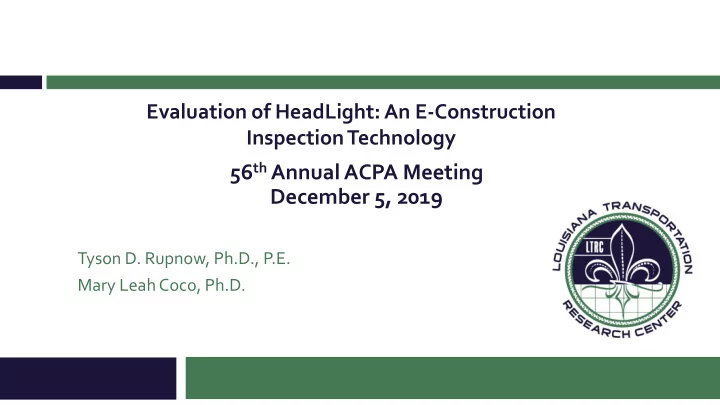

Evaluation of HeadLight: An E-Construction Inspection Technology 56 th Annual ACPA Meeting December 5, 2019 Tyson D. Rupnow, Ph.D., P.E. Mary Leah Coco, Ph.D.
Outline Background Objectives Scope Methodology Results Conclusions Acknowledgements
Background Project delivery (Current) Resource intensive Valuable information Heavily paper based Project delivery (future) Leverage existing technologies Accumulated project intelligence = asset intelligence
Traditional Workflow Material recorded in physical form Transcribed into SiteManager / SiteManager Materials DWRs generated All occurring at the end of the workday after travel back to office Delay in data availability
HeadLight Workflow Material recorded in HeadLight directly via mobile device Observations recorded throughout the day Data available nearly instantaneously Increase in the types of data captured DWRs generated
Why Do the Study? Move Louisiana forward in state-of-the-art inspection procedures Potential for more timely submission of daily working reports (DWRs) Possibly lower the number of claims through more thorough inspection All leading to potential savings for the Department
Why Do the Study? Reduced risk Accelerated delivery Increased accountability Increased efficiency
Objectives Understand impacts on DOTD for leveraging mobile project inspection Time spent on field inspection Quality and quantity of inspection data Timeliness of submission of daily diary documentation Leading indicators for improving claims abatement Asset management Added Materials Module in lieu of asset management objectives
Scope Pilot HeadLight on 12-18 projects across the state Location Size Complexity Up to 200 field inspectors Added Materials Module Over 50 projects statewide piloted with 180 people
Methodology – Materials Identified gaps Material sample tracking Test results Sampling plans
Methodology – Evaluation Metrics and Methods Productivity Timeliness of DWR submission Perception of efficiency Data quality Volume Variety Availability Timeliness of inspection data
Results 12 projects included per method Traditional HeadLight Evaluated per inspector and per project
Equipment
Observations
Documentation
Documentation
Documentation
Results - Productivity
Results - Productivity Reduction spent completing DWRs while in the field is significant 450 people 1 hour per day 2,250 hours per 5-day work week ~117,000 hours per year
Results – Perception of Time Savings Strongly Strongly Survey Question Disagree Neutral Agree Disagree Agree Using HeadLight has allowed me to spend more time in the field 2.50% 2.50% 30.00% 37.50% 27.50% compared to my previous inspection process Number of Responses from Field 1 1 12 15 11 Personnel Using HeadLight has increased my overall efficiency in inspection and 0.00% 15.38% 17.95% 41.03% 25.64% data collection Number of Responses from Field 0 6 7 16 10 Personnel
Results – Data Quality
Results – Data Quality (DWRs)
Results – Observation Types Total Count of Observations New Observation Types Collected Date/Time Stamp 81,367 Location Data 81,367 Image 5,957 Weather 6,734 Video 253 Start/Stop Work 198 Temperature 46 Audio 10 File 9 Density Measurement 6
Results – Data Availability (DWR Submission)
Results – Materials Module Sample tracking Create, track, and manage within HeadLight Similar to UPS, Amazon, etc. via QR code Test results Entered directly into HeadLight Not all forms have been created Sample plan Standardized workflow Assigns standards tests per bid line items
Results – Materials Module
Results – Observed Value Improved coordination and decision making Thorough documentation of deficiencies and corrections Standardization of inspection process Retained HeadLight data as a training resource Centrality, security, and searchability Business process impacts Technology considerations
Conclusions Increased productivity (exceeding 117,000 hours per year) Larger and more diverse volume of data collected More complete and consistent data Improved DWR timeliness (up to 66 and up to 82 percent for 24 hour and 72 hour submission timeframes) Increased accessibility and searchability Increased communication Future training materials Future data leveraging with big data analytics
Recommendations Adopt HeadLight In-Progress! Consider impact on following functions: Management of force account work Contract management Emergency management Construction audit Asset management Investigate impact on quantity and size of change orders and claims
Acknowledgements PRC committee Construction – Mike Vosburg and Matt Jones Materials – Brian Owens, Patrick Icenogle, and Amar Raghavendra OIT – Micah Olivier and Jason Dunlap Field crews – Josh Cook, Lester Fletcher, Dane LeCoq and MANY more Pavia Systems Team Training – Terri Helus (Pavia)
Questions
Recommend
More recommend